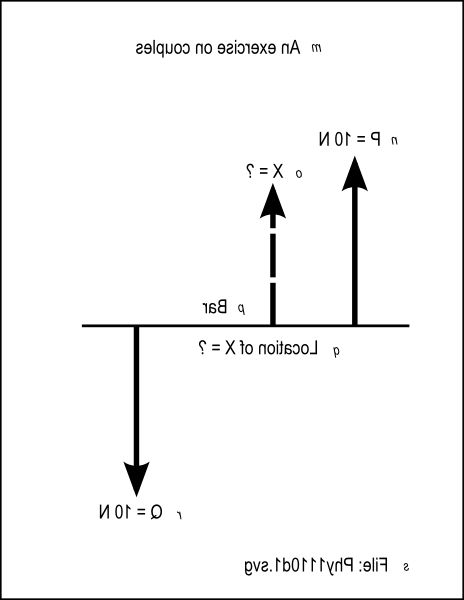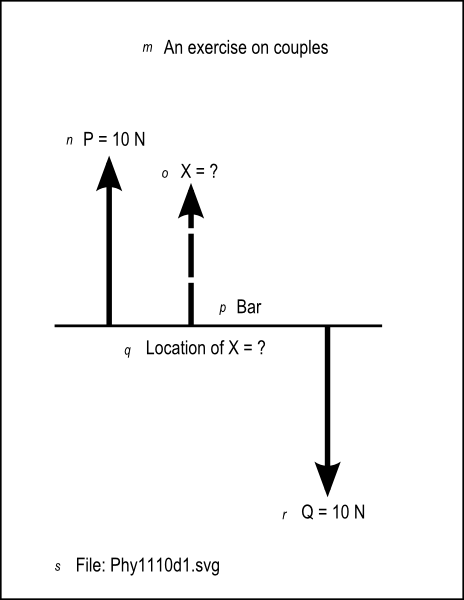| << Chapter < Page | Chapter >> Page > |
Variation of a and P with changes in Q
Now let's see how P and a vary with respect to the value of Q
P = -(W + Q) = 30
a*P +(a+2)*(-20) = 0, or
30*a -20*a -40 = 0, or
10*a = 40, or
a = 4
As you can see, keeping the location of P constant and increasing the value for Q requires the value of P to increase and the location of W to move furtherto the left.
Now draw a new scenario where antiparallel forces, each having a magnitude of 10 newtons are acting in opposite directions on a bar, with each force in the same plane and both forcesperpendicular to the bar. Label one force P and the other force Q.
Tactile graphics
The file named Phy1110d1.svg contains a vector diagram that represents this scenario. It shows two 10 N forces labeled P and Q along with an unknown forcelabeled X.
Figure 11 shows the mirror image that is contained in that file for the benefit of your assistant who will create the tactile graphicfor this exercise.
| Figure 11 . Mirror image from the file named Phy1110d1.svg. |
|---|
 |
Figure 12 shows a non-mirror-image version of the same image.
| Figure 12 . Non-mirror-image version of the image from the file named Phy1110d1.svg. |
|---|
 |
Figure 13 shows the key-value pairs that go with the image in the file named Phy1110d1.svg.
| Figure 13 . Key-value pairs for the image in the file named Phy1110d1.svg. |
|---|
m: An exercise on couples
n: P = 10 No: X = ?
p: Barq: Location of X = ?
r: Q = 10 Ns: File: Phy1110d1.svg |
The moments about a point
If you compute the moments about any point on this bar, they won't sum to zero. Therefore, the bar isn't in equilibrium. Can you find the location andmagnitude of a single force that can be applied to the bar to cause it to be in equilibrium?
Consider the first condition for equilibrium
The vector sum of the forces must be zero.
In this case, the vector sum of the forces is
P - Q + X = 0
10 - 10 + X = 0
where X is an unknown force.
As you can see, there is no value for X that will satisfy this condition other than X=0. If X=0, there is no force, so there is no single force thatcan be applied to the bar to cause it to be in equilibrium.
A couple
Two forces equal in magnitude but opposite in direction and not in the same line constitute a couple .
Stated differently,
A couple is a system of forces with a non-zero moment but no resultant force. In other words, the vector sum of the forces is zero but the sum of the momentsis not zero.
A simple couple
The simplest kind of couple consists of two equal and opposite forces whose lines of action do not coincide. This is often called a "simple couple."
The units for a couple
The SI unit for the torque is the newton meter, which when expanded into SI base units is kg*m^2/s^2.
The moment of force for a couple is unique
The moment of a force is only defined with respect to a certain point P (it is said to be the "moment about P"). In general when P is changed, the moment changes.
However, the moment (torque) of a couple is independent of the reference point P. Any point will give the same moment.

Notification Switch
Would you like to follow the 'Accessible physics concepts for blind students' conversation and receive update notifications?